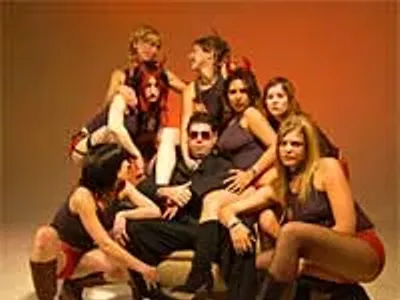
Audio By Carbonatix
[
{
"name": "GPT - Leaderboard - Inline - Content",
"component": "35519556",
"insertPoint": "5th",
"startingPoint": "3",
"requiredCountToDisplay": "3",
"maxInsertions": 100,
"adList": [
{
"adPreset": "LeaderboardInline"
}
]
}
]
Never laugh at your own remarks, even if they’re funny. Don’t push your opinions on others. Never be too literal or too stubborn. Speak less rather than more. Always choose friends that make you look good. Never go to a party alone. Also, try not to go to museums and libraries alone. And if someone asks you to dance, it’s best to honor the request.
These are rules to live by from a pocket-sized etiquette book circa 1847, True Politeness, a Handbook for Ladies. Local fine art photographer Cynthia Greig picked up the soft-covered mini-manual, once a fine lady’s bible, at an antique store.
Most of what we know of 19th century middle- and upper-class women, we see through the prism of Merchant Ivory films. We may snicker at the stereotypes in period pieces, but some of them are legitimate. Ladies swooned a lot, and they definitely needed the hand of a man to steady them as they walked around town. Most days, vigorous activity meant 20 slow steps in a 30-pound dress. White women prided themselves on their pallor and feeble nature, often competing in a well-shaded sitting room about who was sickliest of them all.
Greig and local artist Catherine Smith know this history, as well as the politics of women’s suffrage and reformation, and the struggle of the working class. It’s been written and rewritten by professors and exaggerated by Hollywood. The two of them are interested in the other story, the forgotten one, otherwise known as the version that’s avoided because it’s not neat. It’s about men and women who float between identities and occupations, the lifestyles that defy labels, the events that can’t be placed and the stories that can’t be traced.
In Women in Pants: Manly Maidens, Cowgirls, and Other Renegades (Abrams, $35), Greig and Smith deal specifically with the dress reformation of the 1850s through the 1920s, unraveling a tidy thread of narrative order and exposing reformation as something not always politically motivated.
Believe it or not, the co-authors inform us, decent ladies of the late 19th century were hilarious. Aware of the ridiculous roles society forced upon them, they played practical jokes on their friends and family. And some were also brave enough to risk imprisonment and even death — they’d do anything to get out of a crinoline encrusted in manure and mud from the streets, un-cinch a blood-stained corset and slip into something less hideous and agonizing.
Women in Pants came together through serendipity; two artists shared similar interests but, more importantly, the same perspective. Both grew up believing in the mythology of an elegantly weak Victorian woman, and were also surprised to realize that cross-dressing was a practice that permeated class and race. This affected their expectations of gender, even today.
Greig’s interest in old photos began as a hobby, about 10 years ago. As an art history grad student at the University of Iowa, she went antiquing in neighboring small towns. One of the first photos she found featured a woman whose face is in shadow, and a young child with a pained expression. "It sort of told a story for me, but because it was removed from any context or documentation, and the people were gone, it raised more questions and spoke to me." Greig sought more photos of women and children. She was really interested in the untold story, the pictures’ subjects’ relationships with each other and the intimate gestures between them.
As a grad student at the School of the Art Institute in Chicago in the ’80s, Smith developed an interest in gender studies. But the artist, who now teaches sculpture at Mott Community College in Flint, first became interested in the early history of photography after seeing an exhibition The Life and Work of Isabelle Raymond, was an installation of Greig’s self-portraits as her alter ego, a 19th century photographer, and her subject, the mysterious "M. Claudet."
When Smith saw Greig’s show, she knew they should collaborate. Greig’s toned silver gelatin prints were mounted on cabinet cards and some were set in an environment that suggested Raymond’s studio. The installation allowed visitors to seek and find photos inside drawers and around the room, simulating the discovery that is an addiction for a serious art collector. It’s also the smartest way to allow folks to figure things out for themselves, to begin challenging preconceived notions in American history by coming up with their own version.
Smith began collecting the earliest forms of photography, such as ambrotypes, daguerreotypes, tintypes, cabinet cards, postcards and cartes-de-visites (a lady’s social card that featured her photo, which was dropped in a basket at a friend’s house so the recipient would know who was calling). Over the years, she has bought most of the 500 photos in her collection on eBay — even before it was called eBay — by searching for the key words "women," "dressed" and "men."
The authors say history recognizes the famous and diverse group of women who wore pants as a social statement by rejecting conventions: Joan of Arc, George Sand, Rosa Bonheur, Calamity Jane, Sarah Bernhardt, Colette, Frida Kahlo, Willa Cather and Josephine Baker. But the interesting stories are of ladies who were leading domesticated lives, unrecognized, yet far from ordinary. They cross-dressed so they could memorialize lesbian relationships, or work as gonzo journalists and soldiers, cowgirls and athletes. Some were labeled as deviant cross-dressers simply because they wore pants for practical purposes (women who worked in coal mines were legally forced to wear hot and heavy petticoats). Other women wore men’s clothing to reveal, disguise, empower or mock themselves, and they did it for love, money or sport, for health reasons, out of desperation or just for kicks.
The original bloomer costume was designed in 1851, based on the idea that women could cut skirts to calf-length and wear pants underneath for comfort. The style was named for Amelia Bloomer, a journalist who wrote about the trend in The Lily. Greig and Smith explain that the costume was not completely new; it was influenced by Chinese and Arab women’s wear. And not everyone considered it outrageous. The authors note it was readily adopted by religious communities, such as a Mormon sect in Michigan in 1856. But as a stylish trend for the general public, Smith says, bloomers lasted only a few years before outrage took over.
One chapter in Women in Pants discusses the hundreds of women who disguised themselves so they could fight as soldiers in the Civil War. Most fascinating is the reason they went to such great lengths to get in the trenches: Many enlisted so they could accompany their lovers or husbands, while others were broke enough that the wages seemed worth the risk. And some yearned for an adventure; a violent death seemed more meaningful than the slow drag of a wasted life.
Regardless, by cropping their hair, binding their chests, gluing on whiskers and deepening their voices, women could easily pass as men, especially in the company of teenage male soldiers. In their research, the authors also came across World War I era images of females dressed in uniforms just to take a picture. "Perhaps some women wanted to be soldiers. But by that time there were full medical exams, so it was more difficult to disguise themselves," Smith says. "Or maybe they did it as an expression of something that was denied to them."
While women cross-dressed for a variety of reasons that were personal, social and political, it seems most men simply liked wearing women’s hats for fun, a good joke, which is sometimes the first step society takes toward acceptance. A man donning outrageously ornamental headwear was even a theme in an early cartoon column by Winsor McCay, an early 20th century illustrator whose hallucinatory storylines resulted in some pretty twisted imagery.
Smith’s and Greig’s photo collections of cross-dressing men suggests most of them paraded as ladies for laughs, but this doesn’t make the image of a thick-necked rogue in a maid’s bonnet any less startling. Greig says that early photo processes, especially for ambrotypes, daguerreotypes and tintypes, required lengthy exposure time, which meant the subject had to gaze and sit steady for a while. Sometimes a contraption held the back of a sitter’s neck in an unnaturally stiff position. So the carnivorous glare and postmortem posture may have been unintentionally alarming, but the shock of the image still feels new.
Of the photos featuring men in drag, the most effective are those that seem sincere. There’s no way to claim what’s real and what’s really a ruse, but an expression of love — and the overwhelming sense of self-acceptance that comes when it’s real — is easy to see, no matter how far removed from context. The sign could be even the smallest cue — a hand the size of a catcher’s mitt resting tentatively on another gentleman’s thigh; the way a beefy leg in hosiery — the sagging kind that’s given up staying up — is crossed awkwardly at the knee. But there’s no doubt, in some of these photos, gay lovers express a vulnerability that is touching because it seems more risky than any ostentatious make-out session between two dames.
But possibly the best cross-dressing photo that makes the kind of statement Greig and Smith are interested in is the carte-de-visite of a bearded woman, circa mid- to late-1860s, that is not in the book. The photo, in Greig’s collection, is not included because it’s unclear whether the figure was male or female. The sitter had the photo taken in a proper studio, and the setting bears the furnishings that signal respectability in society. So is this someone trying to get comfortable with her sexuality while presenting herself as a decent member of society? Or is it a spectacularly straight-faced gag? Because this photo is a carte-de-visite, it means the sitter may have received about 10 copies. So what does she intend to do with them? These are the kinds of questions without answers that the co-authors want American history to include. Not everything can be easily explained.
Lately, it’s an art world trend to damage old photos. Artists such as Joseph Heidecker are finding them in their attics or at flea markets, and making collages by blacking out the eyes, typing text over the face, scribbling a beard or a funky-looking cravat. It’s interesting to consider artists who assign themselves power to work over the past, especially since there’s so much of that being done by other prominent public people.
Women in Pants is an effort to remix the stories that society has been told, and dig into some new ones. "I used to think Victorian ladies were staid corseted women," Smith says. "But they were actually dying to get out of the dress and run up a hill."
More than a century later, women have stayed out of the caging that used to be called clothing, but sometimes it seems like they’ve lost sight of the hill.
Women in Pants: Manly Maidens, Cowgirls, and Other Renegades is available online at amazon.com.
Rebecca Mazzei is Metro Times arts editor. Send comments to rmazzei@metrotimes.com




